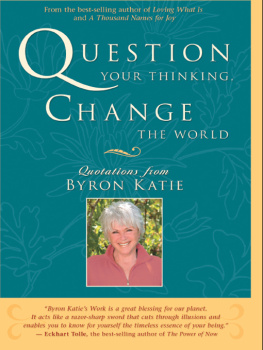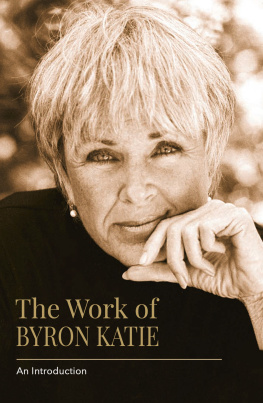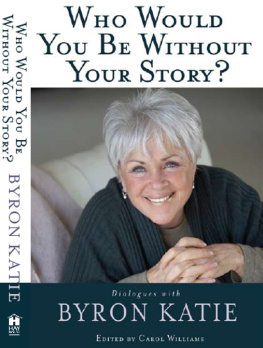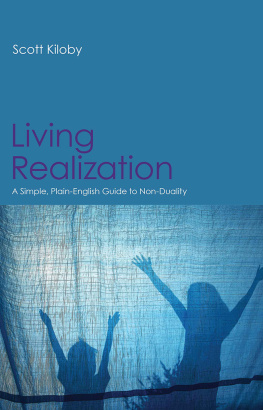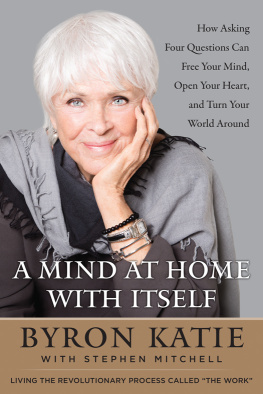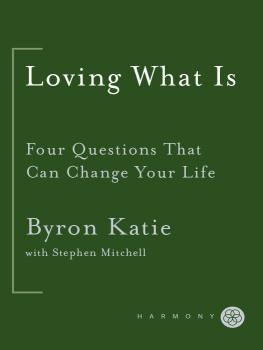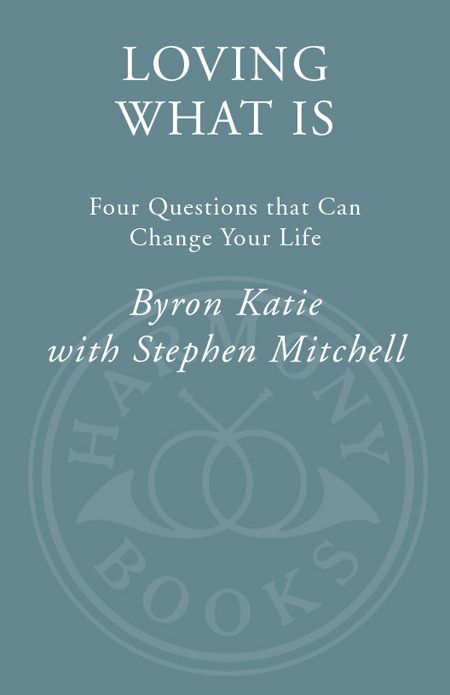
LOVING WHAT IS
Four Questions That
Can Change Your Life
BYRON KATIE
Written with Stephen Mitchell
HARMONY BOOKS
New York
Contents
To Adam Joseph Lewis
and to Michael
Introduction
The more clearly you understand yourself and your
emotions, the more you become a lover of what is.
Baruch Spinoza
The first time I watched The Work, I realized that I was witnessing something truly remarkable. What I saw was a succession of people, young and old, educated and uneducated, who were learning to question their own thoughts, the thoughts that were most painful to them. With the lovingly incisive help of Byron Katie (everyone calls her Katie), these people were finding their way not only toward the resolution of their immediate problems, but also toward a state of mind in which the deepest questions are resolved. I have spent a good part of my life studying and translating the classic texts of the great spiritual traditions, and I recognized something very similar in process here. At the core of these traditionsin works such as the Book of Job, the Tao Te Ching, and the Bhagavad Gitathere is an intense questioning about life and death, and a profound, joyful wisdom that emerges as an answer. That wisdom, it seemed to me, was the place Katie was standing in, and the direction where these people were headed.
As I watched from my seat in a crowded community center, five men and women, one after another, were learning freedom through the very thoughts that had caused their suffering, thoughts such as My husband betrayed me or My mother doesnt love me enough. Simply by asking four questions and listening to the answers they found inside themselves, these people were opening their minds to profound, spacious, and life-transforming insights. I saw a man who had been suffering for decades from anger and resentment toward his alcoholic father light up before my eyes within forty-five minutes. I saw a woman who had been almost too frightened to speak, because she had just found out that her cancer was spreading, end the session in a glow of understanding and acceptance. Three out of the five people had never done The Work before, yet the process didnt seem to be more difficult for them than it was for the other two, nor were their realizations any less profound. They all began by realizing a truth so basic that it is usually invisible: the fact that (in the words of the Greek philosopher Epictetus) we are disturbed not by what happens to us, but by our thoughts about what happens. As soon as they grasped that truth, their whole understanding changed.
Before people have experienced The Work of Byron Katie for themselves, they often think that it is too simple to be effective. But its simplicity is precisely what makes it so effective. Over the past two years, since first encountering it and meeting Katie, I have done The Work many times, on thoughts I hadnt even been aware of. And Ive watched more than a thousand people do it in public events across the United States and Europe, on the whole gamut of human problems: from major illnesses, the deaths of parents and children, sexual and psychological abuse, addictions, financial insecurity, professional problems, and social issues to the usual frustrations of daily life. (Having a reserved seat at all Katies events is one of the privileges of being married to her.) Again and again, I have seen The Work quickly and radically transform the way people think about their problems. And as the thinking changes, the problems disappear.
Suffering is optional, Katie says. Whenever we experience a stressful feelinganything from mild discomfort to intense sorrow, rage, or despairwe can be certain that there is a specific thought causing our reaction, whether or not we are conscious of it. The way to end our stress is to investigate the thinking that lies behind it, and anyone can do this by himself with a piece of paper and a pen. The Works four questions, which you will see in context later in this introduction, reveal where our thinking isnt true for us. Through this processKatie also calls it inquirywe discover that all the concepts and judgments that we believe or take for granted are distortions of things as they really are. When we believe our thoughts instead of what is really true for us, we experience the kinds of emotional distress that we call suffering. Suffering is a natural alarm, warning us that were attaching to a thought; when we dont listen, we come to accept this suffering as an inevitable part of life. Its not.
The Work has striking similarities with the Zen koan and the Socratic dialogue. But it doesnt stem from any tradition, Eastern or Western. It is American, homegrown, and mainstream, having originated in the mind of an ordinary woman who had no intention of originating anything.
To realize your true nature, you must wait for the right
moment and the right conditions. When the time comes,
you are awakened as if from a dream. You understand that what you
have found is your own and doesnt come from anywhere outside.
Buddhist Sutra
The Work was born on a February morning in 1986 when Byron Kathleen Reid, a forty-three-year-old woman from a small town in the high desert of southern California, woke up on the floor of a halfway house.
In the midst of an ordinary lifetwo marriages, three children, a successful careerKatie had entered a ten-year-long downward spiral into rage, paranoia, and despair. For two years she was so depressed that she could seldom manage to leave her house; she stayed in bed for weeks at a time, doing business by telephone from her bedroom, unable even to bathe or brush her teeth. Her children would tiptoe past her door to avoid her outbursts of rage. Finally, she checked in to a halfway house for women with eating disorders, the only facility that her insurance company would pay for. The other residents were so frightened of her that she was placed alone in an attic room.
One morning, a week or so later, as she lay on the floor (she had been feeling too unworthy to sleep in a bed), Katie woke up without any concepts of who or what she was. There was no me, she says.
All my rage, all the thoughts that had been troubling me, my whole world, the whole world, was gone. At the same time, laughter welled up from the depths and just poured out. Everything was unrecognizable. It was as if something else had woken up. It opened its eyes. It was looking through Katies eyes. And it was so delighted! It was intoxicated with joy. There was nothing separate, nothing unacceptable to it; everything was its very own self.
When Katie returned home, her family and friends felt that she was a different person. Her daughter, Roxann, who was sixteen at the time, says,
We knew that the constant storm was over. She had always yelled at me and my brothers and criticized us; I used to be scared to be in the same room with her. Now she seemed completely peaceful. She would sit still for hours on the window seat or out in the desert. She was joyful and innocent, like a child, and she seemed to be filled with love. People in trouble started knocking on our door, asking her for help. Shed sit with them and ask them questionsmainly, Is that true? When Id come home miserable, with a problem like My boyfriend doesnt love me anymore, Mom would look at me as if she knew that wasnt possible, and shed ask me, Honey, how could that be true? as if I had just told her that we were living in China.
Once people understood that the old Katie wasnt coming back, they began to speculate about what had happened to her. Had some miracle occurred? She wasnt much help to them: It was a long time before she could describe her experience intelligibly. She would talk about a freedom that had woken up inside her. She also said that, through an inner questioning, she had realized that all her old thoughts were untrue.
Next page

